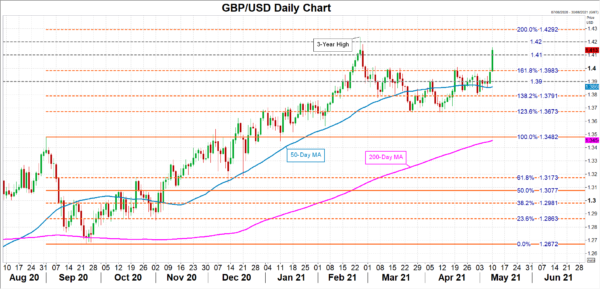UK Prime Minister Boris Johnson has tightened his grip in England but calls for a new Scottish independence referendum have grown louder following last week’s regional and local elections across Britain. The pound is nevertheless rejoicing as the Scottish National Party fell short of a majority in the Scottish Parliament, while Johnson’s Conservatives came out unscathed from the recent sleaze allegations that have been engulfing the party. However, the battle between Holyrood and Westminster has only just begun and while there may be more support for sterling on Wednesday (06:00 GMT) if the Q1 GDP print is not too dire, the political risks have not gone away.
Boris gets thumbs up in England, but trouble brewing in Scotland
Many would say it was only a matter of time before a fresh scandal hit Johnson and his Conservative party. But who paid for the redecoration of the Prime Minister’s apartment in Downing Street is apparently not newsworthy enough for voters during a global pandemic. Instead, the public seem to have judged the government on its superfast vaccine rollout, while a year of Labour under the leadership of Sir Keir Starmer has not changed much in boosting the appeal of the main opposition party.
Labour’s disastrous showing at local council elections and at the Hartlepool by-election in England have raised talk of a leadership challenge as well as increased the odds of Boris Johnson serving a second term as PM. The Conservatives did better than expected in the Welsh Assembly elections too. But in Scotland, it was the pro-independence parties that dominated. The SNP gained one seat, putting them one short of an overall majority. However, the Scottish Green Party, which is also in favour of having another independence referendum, won two extra seats, giving the pro-independence parties the strongest voice in Holyrood.
Scottish referendum: a legal headache?
Yet, markets aren’t seeing an immediate threat of a Scottish referendum as the failure of the SNP to secure an outright majority by itself is being interpreted as weakening its case in getting UK Parliamentary approval to hold a new vote. Under the terms of devolution, matters for the Union are up to Westminster to decide so if the Scottish Parliament unilaterally decided to go ahead with a referendum, it could lead to months of legal wrangling at Britain’s Supreme Court.
However, even if the UK government stands a good chance of winning such a court case, the bigger question is, would Johnson actually block a referendum? Doing so would save the Union for now, but it could also be very damaging as it could not only end up further bolstering Scottish support for independence, but London could be criticized for acting undemocratically. Johnson knows this and although he has described the idea of another independence vote as “irresponsible and reckless”, neither he nor his senior ministers have explicitly said whether the government would reject or fight it in the Supreme Court.
Markets ignore Scottish risk
Looking at the election aftermath in the currency markets, investors are clearly not worried despite the significant risks. The question of whether Scots should be able to decide if they want to leave the 300-year-old Union less than a decade after the last vote was held will almost certainly not go away anytime soon and there is no doubt that SNP leader, Nicola Sturgeon, and Boris Johnson are headed for a collision course.
But investors are focusing on the positives, such as the gradual reopening of the British economy on the back of the successful vaccination programme, as well as the likelihood that the Bank of England will raise rates before the Federal Reserve does. Last week’s decision by the BoE to reduce its weekly bond purchases was followed by a shockingly bad jobs report out of the United States, underscoring the UK’s quickening recovery while disputing the overoptimistic outlook for the US economy.
Is $1.42 next for the pound?
Cable has shot above the $1.41 level today and is now targeting February’s 3-year high of $1.4235. If surpassed, the $1.4292 mark, which is the 200% Fibonacci extension of the September 2020 downleg could next be on investors’ radar.
If, however, a fresh political storm erupts in the coming days or weeks, there should be support for the pound, first in the $1.39 region, followed by the 138.2% and 123.6% Fibonacci levels of $1.3791 and $1.3673, respectively.
UK data overload may not budge sterling
As for this week’s raft of data that’s due on Wednesday, their impact is likely to be limited. The British economy is thought to have contracted by just 1.6% on a quarterly basis in the three months to March even though much of the country was under a tight lockdown for the entire period.
The estimate is a fraction of the near 20% collapse from the first lockdown, highlighting how businesses have adjusted during the course of the year to operating remotely. A worse-than-expected figure might take some of the current heat off sterling, though the separate March readings on GDP, industrial output and trade are likely to point to an upturn at the end of the quarter and may offset a potential disappointment from the headline GDP number.


 Signal2forex.com - Best Forex robots and signals
Signal2forex.com - Best Forex robots and signals




